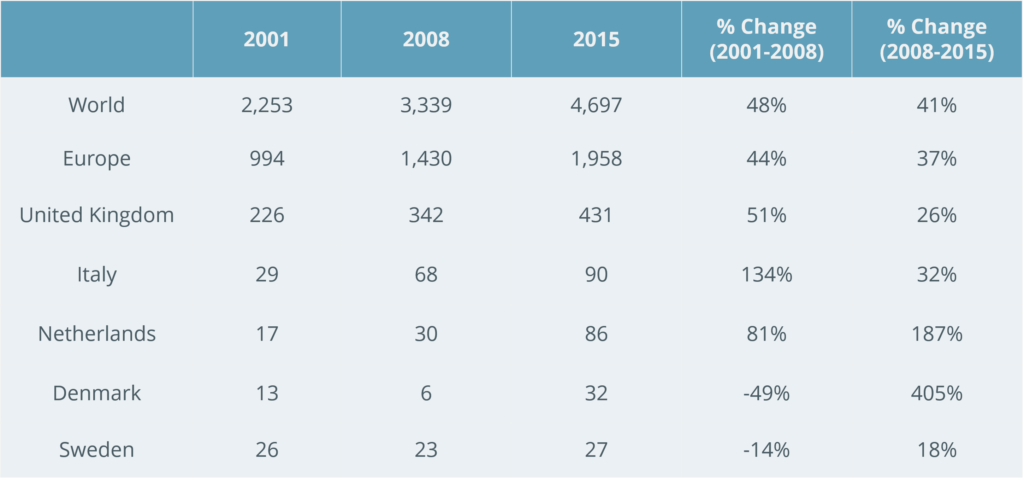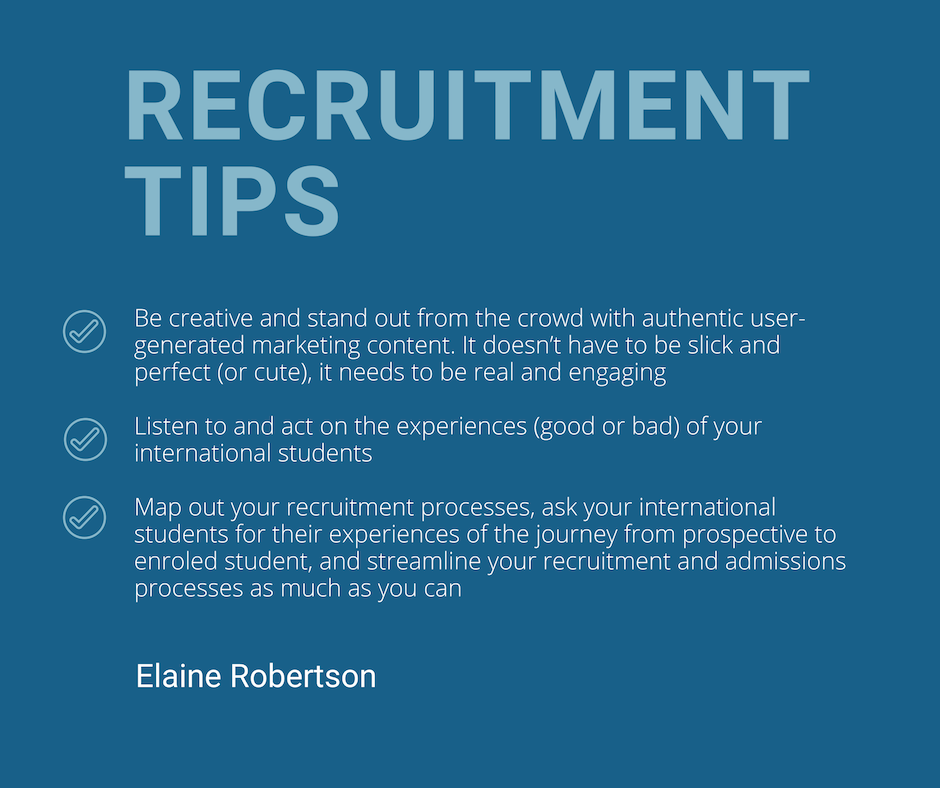Trumping Brexit and the challenges of student recruitment in Europe
The old continent is famed for the quality and accessibility of its higher education. Yet, the recent nationalistic sentiments along with political developments such as Brexit and the introduction of fees in some countries didn’t take too long to deliver a blow to Europe’s ambitions for international students’ growth.
According to a report by Studyportals, the number of globally mobile international students has been on the rise and is projected to reach 6.9 million students by 2030—an increase of 51%, or 2.3 million students, from 2015. And yet, at a deeper level, attracting international students is becoming increasingly competitive and complex. This is especially true for nuanced Europe given it comprises 30+ countries with different domestic policies. It is challenging to look at Europe in terms of market entirety: Here, we observe a unique mosaic of high tuition fees and free education, state and private universities, EU and international students policies, various immigration procedures and varying degrees of international focus.
To get a better grip of the current situation in European higher education, Studyportals hosted a webinar with university leaders from four European countries—Scotland, The Netherlands, France, and Sweden—representing all ends of the spectrum of European higher education to share their approach to international recruitment in times of increasing uncertainty.
Setting the scene for Europe
To talk about what the future holds, it’s useful to look back at history and the patterns that shaped the nature and direction of student mobility in the past.
Against the backdrop of the Three Waves of International Student Mobility, Rahul Choudaha suggests we are at a time of new political order characterised by nationalistic sentiments and unfriendly policies which resist the incoming student waves. Even though the demand for a growing body of international students is there, the climate is not welcoming.
We can observe the dynamic between policies and student enrolments on national level and across the three defined time periods.

The international enrolment numbers for the UK grew faster in Wave I (51%) and slowed down in the next Wave (37%) and are expected to further decrease in Wave III. The Netherlands and Italy, on the other hand, experienced a consistent and robust growth which may face some slowdown in Wave III. Sweden went through considerable decline around the introduction of tuition fees in 2011, and then entered a recovery phase with a projection to repeat its peak numbers from 2001. Denmark faced dramatic decline post tuition introduction in 2006, and fiercely jumped back on the growth curve during the Third Wave.
The factors we see impact the context of higher education today are the following:
- Tightening of post-study work rights
- Increasing tuition fees
- Devaluating currency in emerging markets
- Intensifying competition for student attention
- Growing demand for the “value for money”
What can universities do to overturn the effect of the above while still being relevant for the mobile-first student generation? In search of the answers, Choudaha asked Charlotte M’Doe, Elaine Robertson, Tim Rogers, and Joachim Ekström.
Country-specific barriers hold the key to overcoming them
The collision of national policies and university goals almost inevitably sets a course for a university’s strategy and a sense of urgency to act upon it.
Elaine Robertson says that limited post-study work options and the adversity of Brexit are stimulating universities to lobby for a change. “When policies are not moving fast enough, there is a demand from universities to provide career support and professionally accredited programmes. “We focus on what we can influence – industrial links embedded within our courses are incredibly important to produce work-ready graduates.”
Elaine also emphasized that the perception of how welcoming a country is of high priority to her. Echoing her thoughts, Charlotte M’Doe, Head of Marketing at the University of Groningen, says nationalistic sentiments are an obstacle: “The Netherlands just isn’t ready.” Her solution to the problem is diversifying the student experience that Dutch students can have. “We’re going to bring in students from different countries in slowly increasing portions”.
The readiness to welcome more international students isn’t exclusively related to local sentiments. Growth comes with certain logistical pains as well, and Sweden is a great example of that. “We saw an enormous and unexpected increase in the amount of international, non-EU students last year, likely a result of the Brexit effect” recounts Joachim Ekström, Head of Student Recruitment at Uppsala University. “Sweden happened to be unprepared for the sheer volume of residence permits it had to issue, housing and other immigration work related to welcoming a larger student population, which coincided with the refugee wave in the country.”
Sweden is also a great example of adapting its market and international student strategies to the transition from free education to fees for Non-EU students. To the question what universities can do when tuition fees are being introduced for the first time, Joachim simply said “You cannot prevent the drop in student numbers. Focus on developing an efficient recruitment process instead. This means 1) find out where your students look for educational opportunities and make sure you’re visible there and 2) offer students great service during the application and admissions stages. That will drive the best results.”
Key markets versus key segments
Next to adapting to the country-specific context, university strategies are almost always rooted in the mission and context of the university: whether it’s private or public, general or research-focused.
Private universities like the American University of Paris (AUP) prefer to center their recruitment around the student profile rather than certain markets. Tim Rogers, VP and Director of Enrolment Management at AUP, says that for him the segment trumps the market: “Overcoming the barrier of being unknown and having higher fees means making a very clear decision on the type of student you want and will invest in. Students who apply to the AUP are graded on a scale for being the best fit for the institution. And that scale combines academic background and internationality”.
As far as strategy goes, Tim shares that the AUP would look for schools and locations with high adoption of international curriculum, highest concentration of international schools or the highest concentration of mobile students.
For the equally small University of Uppsala, attracting the right profile post-graduate students is the leading strategy. “It’s nearly hopeless for an international student to make an informed choice about where to study. At Uppsala University, we help prospective students make the best decision based on their career goals and financial capabilities. Offer great advice, not marketing messages.”
Shifting budgets
When diversity and target countries are the primary framework within which university professionals need to operate, looking at the data and a university’s historical footprint is crucial to strategically channel budgets where they’d have the most impact.
“For us, the EU market is paved”, Charlotte shares. Like many European universities aiming to up their share of international Master’s students, the University of Groningen is looking outside the EU. This includes working closely with international faculties, but аlso focusing on “who” they are recruiting and why: ”A lot of effort and resources go into data acquisition, market research, and creating better personas to target where we’re spending our budget”.
Elaine adds that the University of West of Scotland is using market intelligence and horizon scanning to target non-EU Master’s students. To get the right ROI, the university would focus on a niche where their strengths and the local demand intersect. To add to her strategic toolkit, Elaine has approached cohort recruitment by engaging with diplomatic networks and government ministries: “We are looking at emerging markets and country plans that tell us where the demographic is right to train entire cohorts of specialists.”
When strategies are student-centered, admissions staff should grow proportionately to student growth, advises Joachim. He is moving budget from recruitment to admissions. “Applicant numbers are increasing, yet the number of people employed in admissions is still the same. There is little point to bring in applicants if we cannot handle them in time and service them in the best way. Streamlining the process is my priority for the next couple of years.”
“Real” beats “Live” and any recruitment channel
“Anything that’s live is cool these days. It’s also honest” Joachim insists. “Students see through marketing messages – they don’t believe our corporate videos, don’t trust us when we write stuff on our websites or share cute videos. Broadcasting live things that are happening in the university are engaging, fun to watch, and authentic. It’s hard to fake live.”
The significant investment that is studying abroad is also proportionate with student’s high expectations. Students demand more value and attention for their money which is pushing universities to offer live support and personalised communication. “Human contact” is the key word we hear from Tim. “When you charge a large amount – and that’s a warning for everybody – students want more face time, they want to meet a representative.”
“I would never have thought that education fairs would become so effective having done them for the last 30 years, more so that they are becoming an institution like this.”
For Charlotte and Elaine, student recruitment is more on the digital side. They believe in the power of student-generated content to engage the right students. “Moving away from your standard, boring text written by us, and more towards ‘Your first year in gifs’, Instagram stories, and student takeovers,” says Charlotte.
“We have a team of 8 student assistants in my team, and they are actually in full control of the process. They take what we suggest and rip it up. We’ve seen a lot of traffic and students saying it’s great, because it genuinely helps survive a hot week in Groningen. It’s about where you’re going to spend the next year or three years of your life.”
“It’s not always 100% positive but it’s trustworthy and credible because it’s real. We can put all the corporate polish that we want, and we do, and we should because parents are also part of the decision process.” Elaine adds.
It’s about the right mix of channels: “The range of digital platforms out there is immense and we have to make careful choices, bring all that together in a way that is effective – student-generated content, corporate messages, and partnerships.”
Overcoming the challenges
As competition intensifies, universities must become more proactive and innovate in recruiting the next wave of international students. Markets are agile and whatever your successful strategy is today it cannot be the thing you’re focusing on for the next 15 years. How are you preparing your institution for the next years? Listen to Charlotte, Elaine, Tim, and Joachim as they dig deeper into how to stay relevant for students and overcome the challenges of European higher education – watch the webinar here.
For more updates, follow us!








